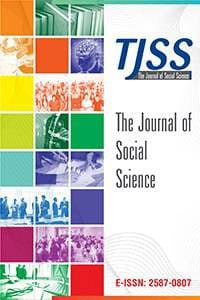TANZİMATTAN CUMHURİYETE MODERN DEVLETE DAİR BİR TARTIŞMA
MODERN DEVLET, OSMANLI DEVLETİ, TANZİMAT, MEŞRUTİYET, ERKEN CUMHURİYET
A DISCUSSION ON MODERN STATE FROM TANZIMAT TO REPUBLIC
Modern State, Ottoman Empire, Tanzimat, Constitutional Monarchy,
___
- KAYNAKÇAAhıska, Meltem (2006) “Türkiye’de “Çevresiz Merkez” ve Garbiyatçılık”, Toplum ve Bilim, İstanbul, Birikim Yay., ss. 11-29.Cerideyi Resmiye, Teşkilatı Esasiye Kanunu, 7 Şubat 1337, No.1.Coşar, Simten (1999) “Türk Modernleşmesi: ‘Aklileşma’, ‘Patoloji’, Tıkanma”, Doğu Batı, Yıl 2, Sayı 8, s. 60. ss. 59-71.Çadırcı, Musa (2007) Tanzimat Sürecinde Türkiye: Ülke Yönetimi, Ankara, İmge Kitabevi.Findley, Carter V. (2011) Modern Türkiye Tarihi: İslam Milliyetçilik ve Modernlik 1789-2007, (Çev. Güneş Ayas), İstanbul, Timaş Yay.Hourani, Albert (1997) “Osmanlı Islahatı ve Seçkinlerin Politikaları”, İslam Dünyası ve Batılılaşma: Değişim ve Sorunlar, İstanbul, Yöneliş Yay., ss. 87-123.Işık, Pınar(2016) “1923 Türk-Yunan Nüfus Mübadelesi: Erken Cumhuriyet Döneminde Modern Devlet Pratikleri ve Dönüşen Kimlikler”, Studies of The Ottoman Domain, Cilt 6, Sayı 10, ss. 84-120.Kandeğer, Barış (2016) Reform Söylemleri Üzerinden Devleti Okumak “İkinci Meşrutiyetten Günümüze”, Yayınlanmamış Dotora Tezi, İstanbul Üniversitesi Sosyal Bilimler Enstitüsü, İstanbul.Karal, Enver Ziya (1988) Osmanlı Tarihi (Nizam-ı Cedid ve Tanzimat Devirleri 1789-1856), V. Cilt, Ankara, Türk Tarih Kurumu Yay.Lewis, Bernard (2008) Modern Türkiye’nin Doğuşu, (Çev. Boğaç Babür Turna), Ankara, Arkadaş Yay.Mantrant, Robert (2000) Osmanlı İmparatorluğu Tarihi II: XIX. Yüzyılın Başlarından Yıkılışa, (Çev. Server Tanilli), İstanbul, Adam Yay.Ortaylı, İlber (2000) Tanzimat Devrinde Osmanlı Mahalli İdareleri (1840-1880), Ankara, Türk Tarih Kurumu Yay.Ortaylı, İlber (2004) İmparatorluğun En Uzun Yüzyılı, İstanbul, İletişim Yay.Önen, Nizam,Reyhan, Cenk (2011), Mülkten Ülkeye: Türkiye’de Taşra İdaresinin Dönüşümü (1839-1929), İstanbul, İletişim Yay.Özekmekçi, İnanç (2012) “Modern Devlet ve Tıp: II. Abdülhamit Dönemınde Frengi ile Mücadele”, Kadın Araştırmaları Dergisi, Sayı 10, ss. 83-101.Öztuna, Yılmaz (1989) II. Mahmud, Ankara, Kültür Bakanlığı Yay.Reyhan, Cenk (2000) “1913 Tarihli Vilâyat Genel İdaresi Geçici Kanunu”, Çağdaş Yerel Yönetimler Dergisi, Cilt 9, Sayı 1, ss. 129-154.Sabahattin, Prens (1999) Görüşlerim, (Haz. Ahmet Zeki İzgör), İstanbul, Buruc Yay.Seyitdanlıoğlu, Mehmet (1994) Tanzimat Devrinde Meclis-i Vâlâ (1838-1868), Ankara, Türk tarih Kurumu Yay.Tanör, Bülent (1996) Osmanlı-Türk Anayasal Gelişmeleri (1789-1980), İstanbul, AFA Yay.Toprak, Zafer (2012) Türkiye’de Milli İktisat 1908-1918, Doğan Kitap, İstanbul.Ubicini, H. A. (1998) Osmanlıda Modernleşme Sancısı, (Çev. Cemal Aydın), İstanbul, Timaş Yay.Weber, Max (1995) Toplumsal ve Ekonomik Örgütlenme Kuramı, (Çev. Özer Ozankaya), Ankara, İmge Kitapevi.Zürcher, Erik Jan (1995) Modernleşen Türkiye’nin Tarihi, İstanbul, İletişim Yay.
- Yayın Aralığı: Yılda 2 Sayı
- Başlangıç: 2017
- Yayıncı: Cenk AKSOY
ERGENLERDE BİLGİSAYAR OYUNLARININ ETKİLERİ
YAS SÜRECİNDEKİ ERGENLERİN DİSSOSİYATİF YAŞANTILARI VE PSİKOLOJİK BELİRTİLERİNİN İNCELENMESİ
KURUMSAL MARKALAŞMA ve İTİBAR YÖNETİMİ SÜRECİNDE SOSYAL MEDYANIN KULLANIMI
KİMYA PROGRAMI ÖĞRENCİLERİNİN ORGANİK KİMYA FARKINDALIKLARI (KMYO ÖRNEĞİ)
TÜRK TİPİ LİDERLİK: SABRİ ÜLKER ÖRNEĞİ
NOSTALGIC EVOLUTION OF MARKETING: RETRO MARKETING
ETEK ÜRETİMİNDE ÖRNEK BİR ANALİTİK HİYERARŞİ YÖNTEMİ UYGULAMASI
POSTÜRÜ PROBLEMLİ VÜCUTLARIN GİYSİ KALIBI AÇISINDAN İNCELENMESİ
GENÇ YETİŞKİNLERDE MUTLULUĞUN MANEVİYAT VE KANAAT AÇISINDAN İNCELENMESİ
